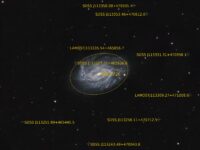NGC 3726

Click image for full size version
June 30, 2024
NGC 3726 is a rather small galaxy (on the sky) located under the bowl of the Big Dipper. It’s about 45 million light years from us and is about 85,000 light years across. The galaxy has a short central bar that contains a supermassive black hole about 3 million times the Sun’s mass. NGC 3726 is also reported to have a massive dark matter halo. You’ll also see some pink H-alpha knots within the spiral arms.
There are also many quasars in this image, marked in this annotated version of the above image. Quasars are extremely distant active galaxies, with some being more than 10 billion years away. The farthest quasar I have spotted in my own images was at an incredible 12.2 billion light years distant.
Tekkies:
Acquisition, focusing, and control of Paramount MX mount with N.I.N.A., TheSkyX and PHD2. Primalucelab low-profile 2″ Essato focuser and ARCO rotator. Guiding with PHD2. Equipment control with PrimaLuce Labs Eagle 4 Pro computer. Flats taken using a Primalucelab Giotto 430 mm flat panel. All pre-processing and processing in PixInsight. Acquired from my SkyShed in Guelph. Data acquired under nearly moonless skies (except for H-alpha, under moderate moonlight) with average or better transparency and seeing April 25-26, 2024.
Celestron 14″ EDGE HD telescope at f/11 (3,940 mm focal length, determined from images) and QHY600M camera binned 2×2 with Optolong filters.
21 x 5m Red = 1hr 45m
20 x 5m Green = 1hr 40m
20 x 5m Blue = 1hr 40m
20 x 5m Ha = 1hr 40m
Total: 6hr 45m
Preprocessing: The WeightedBatchPreProcessing script was used to perform calibration, cosmetic correction, weighting, registration, local normalization and integration of all frames.
RGB master: A master RGB image was made from the Red, Green and Blue masters using ChannelCombination in RGB mode.
Gradient Removal: DBE was used to remove gradients from the RGB and Ha masters.
Colour Calibration: SpectroptometricColorCalibration was used to calibrate the RGB master.
Deconvolution: BlurXterminator was applied to the two masters with Automatic psf , star sharpening set to 0.4, and non-stellar set to 0.5.
Star Removal: StarXterminator was used to remove the stars from both masters, with Large Overlap and Unscreen Stars selected. Only the RGB stars-only image was retained.
Linear Noise Reduction: NoiseXterminator was applied to the both masters with settings Amount=0.9 and Detail=0.25
Ha Continuum Subtraction: The ContinuumSubtraction script was used to remove continuum emissions from the Ha image.
Stretching: HistogramTransformation was applied to both masters to make pleasing images. Approximate background level after stretch was 0.08 for Ha and 0.10 for RGB.
Nonlinear Processing
Addition of Ha to RGB: The NBRGBCombination script was used to add Ha to the RGB
Nonlinear Noise Reduction: NoiseXterminator was applied to the image with Amount=0.9 and Detail=0.15.
Re-stretch: HistogramTransformation was used to boost contrast by moving the dark point to the toe of the histogram and slightly decreasing the mid-point slider.
Contrast Enhancement: Using a mask, the core was compressed with the CreateHDRImage script using 5 layers, Median Transform and a 30% blend of the compressed image with 70% original. LocalHistogramEqualization was applied twice. A Contrast Limit of 1.5 and 1 iteration was used for each LHE application (scale 50, strength 0.25; scale 120, strength 0.2).
Sharpening: MultiscaleMedianTransform was applied. (Layers 2 – 4 with strengths of 0.06, 0.06, and 0.03, respectively), using a mask to select only the galaxy.
Contrast, Brightness and Colour: Background and galaxy brightness, contrast, and saturation were adjusted in several iterations using CurvesTransformation with masks as required.
Stars-only steps: HistogramTransformation was applied to the RGB stars-only image. A mask was made by using ChannelExtraction to extract the luminance from the image. CurvesTransformation CIE c* slider was used to add boost colour in the stars through the star mask. A mask was made to select the largest star and CurvesTransformation was used to make it a little smaller.
Star Restoration: PixelMath expression combine(starless, stars, op_screen()) was used to combine the starless HaRGB starless image with the stars-only image.
Final Steps: Background, galaxy, and star brightness, contrast, hue, and saturation were adjusted in several iterations using CurvesTransformation with masks as required. ICCProfileTransformation (sRGB IEC61966-2.1; Relative Colorimetric with black point compensation) was applied prior to saving as a jpg. The finder chart was made using the FindingChart process. The annotated version was made using the AnnotateImage script.








it’s so beautiful!
Outstanding work Ron, I am like a sponge 🧽 trying to absorb it all.
Thanks Tom! Gldad you are enjoying the photos.